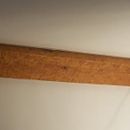Why did the beam at the top of my cathedral ceiling just start sweating after 5 years?
This spring the beam at the top of my cathedral celing just started sweating after 5 years of being dry all year. It started about a month or 2 ago,~ April.
The beam is actually a box beam covering an LVL. The roof, walls & gable end are insulated with open cell foam. The ceiling doesn’t get wet only the beam.
No water entering during rain storms. We’ve never had a moisture problem actually we use a humidifier in the winter. We have a hot air geothermal heating system so the humidifier in the system can’t maintain the correct moisture level.
Totally confused as to the origin of this problem.
Theoallen,
In Massachusetts
GBA Detail Library
A collection of one thousand construction details organized by climate and house part











Replies
Theo,
You are the third person to post a question on GBA with this symptom. (Here is a link to one of the previous questions: Why is there condensation on my cathedral ceiling?)
Here is my current theory: There is no insulation above your ridge beam. The ridge of your roof gets cold on clear nights due to night sky radiation cooling. (For more information on this phenomenon, see Night Sky Radiation.)
If the sky is clear enough, the ridge beam loses enough heat to outer space -- in other words, becomes cold enough -- to become a condensing surface for interior moisture. (The source of the moisture is the interior air.)
One way to confirm whether this theory applies in your case is to note the weather when the phenomenon occurs. If you notice the condensation after a cloudless night - bingo! You have your explanation.
The solution would be to open the ridge from the exterior, perform air sealing work if necessary -- depending on whether you have a vented or an unvented roof -- and figure out a way to retrofit some rigid foam insulation above your ridge beam.
Martin Holladay: I do agree to a point but the beam is 14" high and has foam insulation on both sides so the cooling effect would have to be conduction. Secondly the box beam is not in direct contact with the beam with a minimum of 1/2" clearance so it seems tough for your theory to work.
Now this morning 7 am there is no condensation on the beam. The windows were open all night and no condensation on the beam.
The strange thing is the room has been finished for 5 years and we have never experienced this issue.
I have put a hygrometer up near the beam to check the humidity up there. We'll see what happens today with the door to the room closed to the rest of the house.
Would it make sense to put insulation "under" the ridge so that the ridge is encapsulated in insulation?
E247,
You are correct. If night sky radiation is, indeed, the cause of this problem, then installing a layer of rigid foam under the beam would solve the problem. Of course, the rigid foam would need to be protected on the interior by a layer of drywall.
The airspace between the box and the beam might also be the problem. It might be allowing cold air to drop from the ridge down to the bottom of the beam. If the foam is in contact with the beam for most of the 14", then this isn't the problem. Is it possible that cold air is shooting longways through the air space from an end wall?
Using an IR thermometer to measure the temperature of the box in different weather conditions, including when it is sweating might help with diagnosis. Also the time of day when the sweating is worst.
It could be the thermal mass of the beam. Even a wood beam has a fair amount of mass. If that mass is chilled during the night and we have a suddenly warm, humid day (pretty common in spring in the northeast), the beam might be chilling the box enough to get condensation if the windows are open.
The specific time/temperature/weather conditions will probably lead to the answer.
Well for now the condensation has stopped. We'll be watching to see if it starts back up on the fall then we can track the contributing factors.
Thanks everyone for your input.